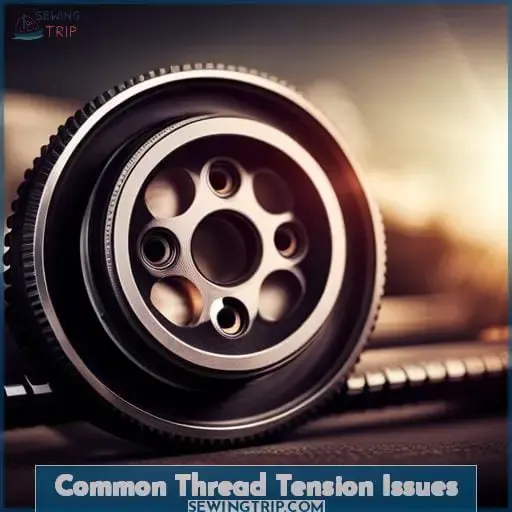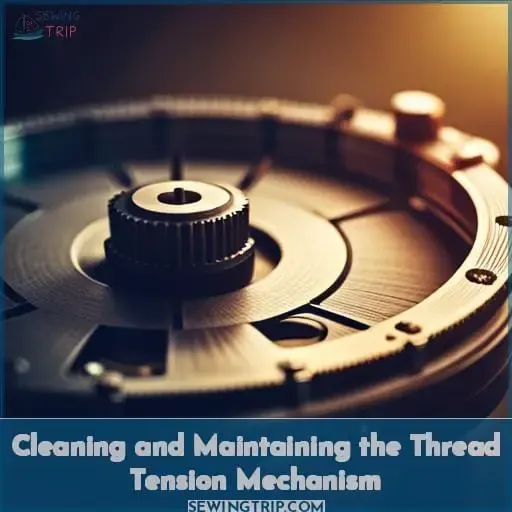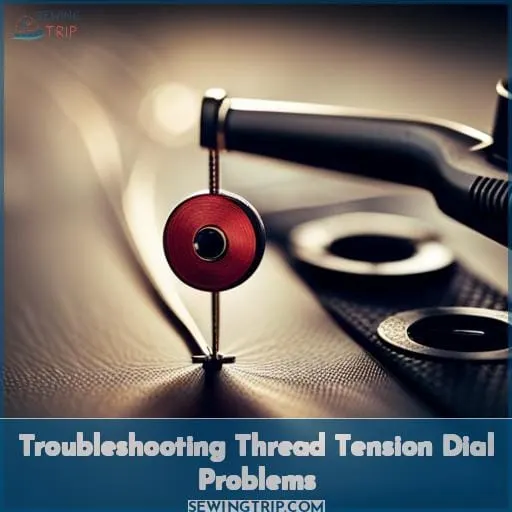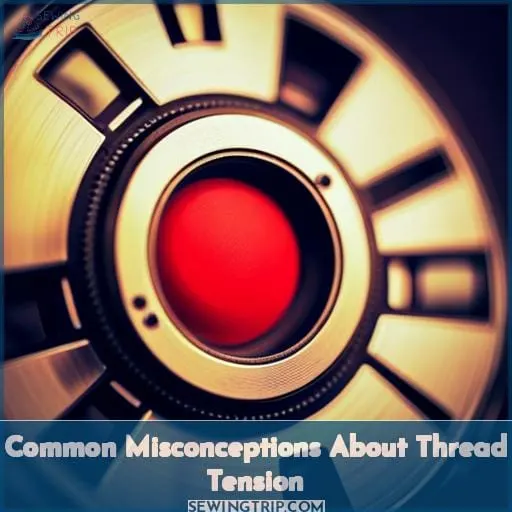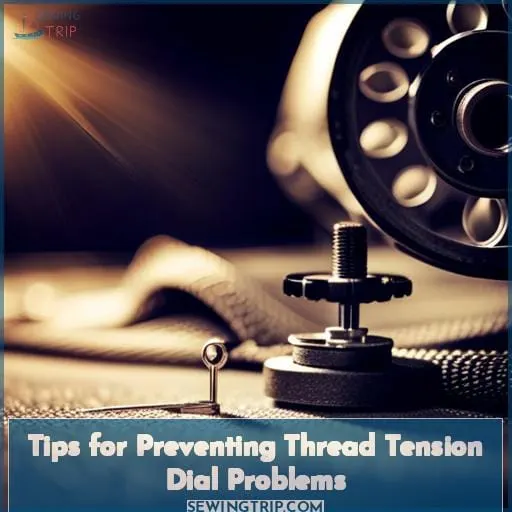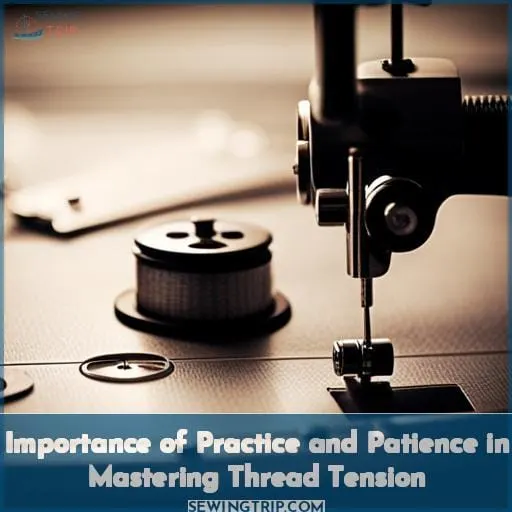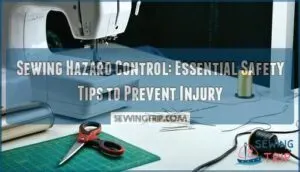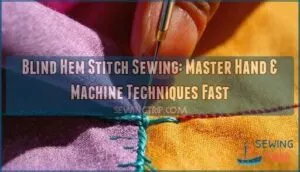This site is supported by our readers. We may earn a commission, at no cost to you, if you purchase through links.
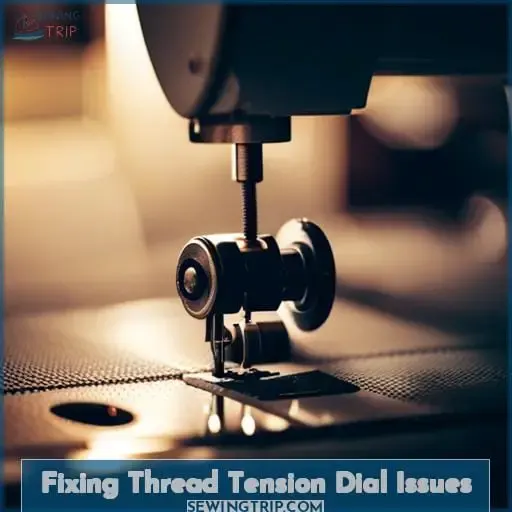 Imagine this: you’re in the middle of a sewing project, feeling empowered and creative. But suddenly, your stitches start acting up, ruining your masterpiece. Don’t worry! You’re not alone. Thread tension dial problems are common for many sewers like yourself. However, with a little know-how and some simple adjustments, you can fix these issues and regain control over your machine.
Imagine this: you’re in the middle of a sewing project, feeling empowered and creative. But suddenly, your stitches start acting up, ruining your masterpiece. Don’t worry! You’re not alone. Thread tension dial problems are common for many sewers like yourself. However, with a little know-how and some simple adjustments, you can fix these issues and regain control over your machine.
In this article, we’ll guide you through troubleshooting thread tension dial problems to help you achieve flawless stitches every time.
Table Of Contents
- Key Takeaways
- Common Thread Tension Issues
- Checking and Adjusting Thread Tension
- Potential Problems With the Thread Tension Dial
- Cleaning and Maintaining the Thread Tension Mechanism
- Troubleshooting Thread Tension Dial Problems
- Seeking Professional Help for Persistent Thread Tension Issues
- Common Misconceptions About Thread Tension
- Tips for Preventing Thread Tension Dial Problems
- Importance of Practice and Patience in Mastering Thread Tension
- Frequently Asked Questions (FAQs)
- Conclusion
Key Takeaways
- Common thread tension issues include loose stitches, puckering, uneven stitches, and breaking thread.
- Potential problems with the thread tension dial include a stiff or difficult-to-turn dial, inaccurate tension settings, and a non-responsive dial.
- Troubleshooting thread tension dial problems involves checking needle condition and size, using high-quality thread, and inspecting the bobbin and bobbin case.
- It is important to avoid common misconceptions about thread tension, such as blaming it for all sewing issues and overlooking other possible causes of problems.
Common Thread Tension Issues
If you’re experiencing loose stitches, puckering, uneven stitches, or thread breakage while sewing, it’s likely that you’re dealing with common thread tension issues. These problems can occur due to improper settings on the tension dial of your sewing machine.
Understanding and addressing these issues is crucial for achieving high-quality stitching results.
Loose Stitches
If you’re experiencing loose stitches while sewing, it’s likely due to a thread tension issue.
Loose tension can result in uneven and sloppy stitching that compromises the quality of your project.
To address this problem, start by checking your threading technique and ensuring proper bobbin adjustment.
Experiment with different stitch lengths and types to find what works best for your fabric compatibility.
Remember that practice and patience are key when mastering thread tension troubleshooting techniques.
Puckering
To fix puckering caused by thread tension issues, adjust the tension dial on your sewing machine.
Use these adjustment techniques to resolve the problem:
- Gradually increase or decrease top tension using the dial.
- Test adjustments on scrap fabric with contrasting threads.
- Ensure proper bobbin threading and consider adjusting bobbin tension if necessary.
- Troubleshoot thread winding, correct bobbin type, and potential damage in the bobbin case.
- Seek professional guidance if problems persist despite troubleshooting efforts.
Uneven Stitches
Experiencing uneven stitches is a common thread tension issue that can be frustrating while sewing.
Analyzing stitch patterns and understanding fabric variations are key to visualizing tension problems.
Expert tips and troubleshooting techniques include:
- Adjusting the thread tension dial
- Making bobbin tension adjustments if necessary
- Considering needle replacement for optimal stitching
- Ensuring regular cleaning of the sewing machine to avoid any potential issues with uneven stitches caused by improper thread tensions.
Breaking Thread
When experiencing the frustrating issue of breaking thread, understanding the role that thread tension plays is crucial.
- Thread Friction: Improper tension can cause excessive friction between the upper and bobbin threads, leading to breakage.
- Bobbin Interaction: Incorrect bobbin tension or improper threading can contribute to thread breakage.
- Tension Troubleshoot: Check both upper and bobbin tensions for any issues or inconsistencies.
- Dial Lubrication: Ensure that the tension dial is properly lubricated for smooth operation and accurate adjustments.
By addressing these factors, you can effectively troubleshoot and resolve issues with breaking thread during sewing projects.
Checking and Adjusting Thread Tension
To ensure optimal stitching results, it’s crucial to understand the thread tension dial on your sewing machine.
Start by testing the tension on a scrap fabric with contrasting threads to identify any imbalances.
Adjusting thread tension may be necessary when working with different fabrics or using specialty threads.
By familiarizing yourself with these concepts and making small adjustments as needed, you can achieve consistent and high-quality stitches for all your sewing projects.
Understanding the Thread Tension Dial
When checking and adjusting thread tension on your sewing machine, it’s important to understand the function of the thread tension dial.
The tension dial controls the balance between top and bobbin tensions, ensuring even stitches. If you’re experiencing loose or tight stitches, puckering, or breaking threads, it may be due to incorrect tension settings.
By familiarizing yourself with the thread tension dial and making appropriate adjustments based on troubleshooting results, you can achieve optimal stitch quality for your projects.
Testing Thread Tension on Scrap Fabric
To test the thread tension on scrap fabric, continue by:
- Placing the fabric under the presser foot and positioning it appropriately.
- Using a light-colored fabric with different-colored threads for clarity.
- Checking for imbalances in thread tug-of-war between top and bottom stitches.
- Adjusting top tension using the dial, gradually increasing or decreasing as needed.
- Testing bobbin tension by allowing it to unwind and adjusting with a small screwdriver if necessary.
Adjusting Tension for Different Fabrics and Threads
Adjust tension according to the fabric and thread you’re using.
Different fabrics and threads require different tension settings to achieve optimal results.
Refer to the table below for guidance on adjusting top and bobbin tension based on fabric type, thread type, and thread thickness.
Finding the ideal tension setting will ensure good thread tension throughout your sewing project.
| Fabric Type | Thread Type | Thread Thickness |
|---|---|---|
| Cotton | Polyester | Medium |
| Silk | Rayon | Fine |
| Denim | Nylon | Moderate |
Potential Problems With the Thread Tension Dial
If you’re experiencing stiffness or difficulty turning the thread tension dial on your sewing machine, it could be due to a few potential problems.
- One possible issue is that the dial may have accumulated dust or debris over time, causing it to become stiff and unresponsive.
- Another possibility is that there may be internal mechanical issues with the tension control mechanism itself, such as misalignment or worn-out parts.
- Lastly, if you find that your thread tension settings aren’t accurately reflected in your stitches despite adjusting the dial, there could be an issue with calibration or accuracy of the tension system.
Stiff or Difficult to Turn Dial
If you’re experiencing a stiff or difficult to turn dial on your sewing machine’s thread tension mechanism, it could indicate potential problems with the overall functionality of the dial.
This issue can arise due to various causes, such as:
- Dirt or debris buildup
- Lack of lubrication
- Worn-out components
To resolve this problem, regular maintenance is crucial. Cleaning and lubricating the tension mechanism periodically will ensure smooth operation and prevent costly replacements down the line.
Troubleshooting videos can provide helpful guidance in resolving stiffness issues with your thread tension dial.
Inaccurate Tension Settings
If you’re experiencing inaccurate tension settings on your sewing machine, it can be frustrating and affect the quality of your stitches.
- Check the tension dial markings to ensure they’re accurate.
- Locate the tension dial and make sure it’s functioning properly.
- Troubleshoot any issues with the tension dial by cleaning or repairing it if necessary.
By addressing these potential problems with the thread tension dial, you can achieve balanced tension for optimal stitching results without compromising user error or neglecting machine maintenance needs related to thread spool issues and tight tensions.
Dial Not Responsive to Adjustments
When the thread tension dial fails to respond to your adjustments, it can be frustrating and hinder your sewing progress.
It may be:
- Stuck
- Damaged
- Loose
- Misaligned
- Dirty
These issues can prevent you from achieving the desired tension for your stitches and may require further troubleshooting or professional assistance to resolve.
Cleaning and Maintaining the Thread Tension Mechanism
To ensure proper functioning of the thread tension mechanism, it’s essential to regularly clean and maintain it.
Start by removing lint and debris that may have accumulated around the tension discs using a small brush or compressed air.
Additionally, lubricate the tension discs with sewing machine oil to promote smooth movement.
Finally, inspect for any damaged or worn parts that may be affecting the performance of the thread tension mechanism and replace them as necessary.
Removing Lint and Debris
To properly maintain the thread tension mechanism, regularly remove lint and debris from the sewing machine.
Lint build-up can clog the bobbin case and affect the smooth operation of tension discs.
Use a screwdriver to access hard-to-reach areas and ensure thorough cleaning.
Testing tension after lint removal will help you identify any remaining issues.
Keep your sewing machine in top condition by incorporating regular maintenance, including proper lint removal techniques into your sewing routine.
Lubricating the Tension Discs
Lubricate the tension discs regularly to ensure smooth operation and optimal thread tension.
Use sewing machine oil to apply oil to the tension discs, bobbin case, needle thread tension, and bobbin thread tension.
Proper lubrication helps reduce friction between components in the tension mechanism, promoting seamless movement of the threads.
This maintenance step is essential for maintaining consistent stitch quality and preventing issues like skipped stitches or erratic tensions.
Checking for Damaged or Worn Parts
To ensure smooth operation of your sewing machine, regularly check for any damaged or worn parts in the thread tension mechanism.
Inspect for:
- Worn tension discs
- Rusted tension screws
- Broken tension springs
- Damaged tension levers
These issues can disrupt the proper functioning of your machine and affect thread tension.
If you notice any problems with these components, it’s recommended to seek assistance from a professional sewing machine repair shop to avoid further damage and ensure optimal performance.
Troubleshooting Thread Tension Dial Problems
To troubleshoot thread tension dial problems, there are several key points to consider:
- Check the condition and size of your needle as this can affect tension.
- Ensure you’re using high-quality thread that’s suitable for your project.
- Inspect the bobbin and bobbin case for any issues that may be causing tension inconsistencies.
By addressing these points, you can effectively troubleshoot and resolve thread tension dial problems on your sewing machine.
Checking Needle Condition and Size
When troubleshooting thread tension dial problems, start by checking the condition and size of your needle.
A bent, dull, or broken needle can cause stitching issues and affect tension.
Make sure the needle isn’t damaged or mismatched for your machine.
Consider using quality thread to prevent further complications.
Beginners may find it helpful to consult a sewing machine shop for advice on selecting the right needle size for their projects as a stitch starter.
Using High-quality Thread
Now let’s talk about the importance of using high-quality thread when troubleshooting thread tension dial problems.
Using high-quality thread helps avoid lint buildup, which can clog the machine and affect tension.
High-quality thread reduces the risk of over-threading, preventing tangles and uneven stitches.
By using correct needle size in combination with high-quality thread, you ensure smooth stitching and balanced tension.
Remember to test your tension adjustments on scrap fabric for optimal results!
Inspecting the Bobbin and Bobbin Case
Check the bobbin and bobbin case for any potential issues when troubleshooting thread tension dial problems.
Inspect the bobbin type, ensuring it’s compatible with your machine.
Look for any signs of the bobbin thread caught or unwinding improperly.
Check that the bobbin is wound correctly and securely in its case to prevent tension disruptions.
Proper inspection of these components can help resolve thread tension issues and ensure smooth sewing operations.
Seeking Professional Help for Persistent Thread Tension Issues
If you have tried all the troubleshooting steps and are still experiencing persistent thread tension issues, it may be time to seek professional help.
Consulting a sewing machine technician can provide expert guidance and ensure that the specific dial problem is properly diagnosed. They’ll conduct a thorough inspection of your machine to identify any underlying mechanical issues that may be causing the tension problems.
Consulting a Sewing Machine Technician
If you’re still experiencing persistent thread tension issues, have you considered consulting a sewing machine technician for professional help? Here’s what to expect from a technician:
- They’ll diagnose and assess the problem with your machine.
- The cost of a tension adjustment may vary depending on the technician and location.
- Bring your sewing machine, any relevant documentation, and samples of the stitching issue to the appointment.
- The length of the appointment can range from 30 minutes to an hour or more.
- If they’re unable to fix the problem, they may recommend further repairs or suggest alternative solutions.
Explaining the Specific Dial Problem
If you frequently experience persistent thread tension issues, it’s time to seek professional help and explain the specific problem with your sewing machine’s tension dial.
Whether the dial isn’t turning, labeled incorrectly, not working properly, adjustable or calibrated correctly; a sewing machine technician can provide the expertise needed to address these specific issues.
Don’t let these problems hold you back from achieving mastery in your sewing projects.
Getting a Thorough Machine Inspection
When experiencing persistent thread tension issues, it’s time to have your sewing machine thoroughly inspected by a professional.
- Identifying tension issues: A skilled technician can pinpoint the exact problem.
- Testing and troubleshooting bobbin tension: They’ll test and adjust the bobbin tension for optimal results.
- Adjusting bobbin tension: Professionals know how to fine-tune the delicate balance between top and bottom threads.
- Spool setup and orientation, threading guides: They’ll ensure proper setup of spools and guide threading for smooth stitching.
Don’t let thread tension woes hold you back – get professional assistance!
Common Misconceptions About Thread Tension
Don’t fall into the trap of blaming thread tension for every sewing issue you encounter. While it plays a crucial role in achieving optimal results, overlooking other potential causes can lead to frustration and wasted time.
Understanding the true role of tension in sewing will help you troubleshoot more effectively and address problems with confidence.
Blaming Thread Tension for All Sewing Issues
Are you convinced that thread tension is the root cause of all your sewing issues?
While thread tension plays a role in stitching quality, it’s important to understand that it’s not always the problem.
Other causes, such as incorrect machine threading, needle maintenance, and machine care can also lead to sewing issues.
To test for proper tension, use contrasting threads on light-colored fabric.
If problems persist despite troubleshooting efforts, don’t hesitate to seek professional help.
Overlooking Other Possible Causes of Problems
Don’t make the mistake of solely blaming thread tension for all your sewing issues.
Common mistakes and misconceptions about thread tension can lead to unnecessary troubleshooting.
Remember to consider other possible causes when experiencing tension problems, such as incorrect fabric types or bobbin tension issues.
Take the time to troubleshoot and refer to sewing guides for comprehensive solutions that go beyond simply adjusting thread tension on your sewing machine.
Understanding the Role of Tension in Sewing
One common misconception about thread tension in sewing is that it’s the cause of all stitching issues. While tension plays a crucial role in achieving balanced and even stitches, there are other factors to consider when troubleshooting sewing problems.
Understanding the importance of balance between top and bottom tension is key to resolving issues effectively. By considering various aspects of your machine setup, you can troubleshoot potential causes beyond just thread tension adjustments.
| Importance | Balance | Top Tension | Bottom Tension |
|---|---|---|---|
| Ensures even stitching on both sides | Facilitates smooth thread flow while sewing | Maintains equal tension between top and bottom stitches | Prevents issues like top thread being too loose or bottom too tight |
Tips for Preventing Thread Tension Dial Problems
To prevent thread tension dial problems, it’s important to:
- Regularly clean and maintain your sewing machine.
- Remove lint buildup and oil the machine as recommended in the manual.
- Use the correct thread and needle for the fabric you’re working with to avoid unnecessary tension adjustments.
Remember that excessive tension adjustments can lead to further issues, so approach them with caution and seek professional help if needed.
Regularly Cleaning and Maintaining the Machine
To prevent thread tension dial problems, it’s essential to regularly clean and maintain your sewing machine.
- Clean the bobbin case: One common cause of thread tension issues is lint accumulation in this area. Use a soft brush or compressed air to carefully remove any buildup without causing damage.
- Avoid using harsh chemicals: When cleaning your machine’s exterior surfaces, avoid using strong solvents as they can deteriorate certain materials over time.
- Lubricate the thread guides: Apply a small amount of oil (specifically designed for sewing machines) on both sides of each guide where threads pass through them during stitching process – but be careful not to use too much oil which could attract more dirt!
By following these simple maintenance steps regularly, you can keep your sewing machine running smoothly and minimize potential issues with its thread tension adjustment system.
Using the Correct Thread and Needle for the Fabric
To prevent thread tension dial problems, use the correct thread and needle for your fabric.
Using the wrong combination can cause issues such as loose stitches or puckering.
Refer to this handy table when selecting your materials:
| Fabric Type | Thread | Needle |
|---|---|---|
| Light | Thin thread | Sharp needle |
| Heavy | Thick thread | Ballpoint needle |
| Knit | Use a needle with a sharp point and a slightly larger eye than the thread. | |
| Woven | Use a needle with a sharp point and a slightly smaller eye than the thread. | |
| Slippery | Use a needle with a ball point tip and a slightly larger eye than the thread. |
Choosing the appropriate supplies will ensure smooth stitching and optimal tension control.
Avoiding Excessive Tension Adjustments
To avoid unnecessary tension adjustments that can potentially cause issues with your sewing machine, follow these tips for preventing thread tension dial problems:
- Always test the tension on scrap fabric before starting a project.
- Avoid overtightening the tension dial; make gradual adjustments instead.
- Consult your machine’s manual for specific instructions on adjusting thread tension.
- Use a screwdriver to adjust the bobbin if necessary, following manufacturer guidelines.
- Sew with a light hand to prevent excessive pressure on the threads.
Importance of Practice and Patience in Mastering Thread Tension
Mastering thread tension requires practice and patience.
Experiment with different tension settings on scrap fabric to see how it affects your stitches.
Keep a record of successful adjustments for future reference, as thread tension may vary with each project.
Remember that becoming proficient in adjusting thread tension takes time and persistence, but the results will be well worth the effort.
Experimenting With Different Tension Settings
As you continue to navigate the challenges of thread tension dial issues, it’s crucial to understand the importance of practicing and being patient while experimenting with different tension settings.
When working with light fabric, a loose tension may result in puckering. On the other hand, heavy fabric requires tight tension to prevent skipped stitches.
Be mindful of correct threading for both bobbin and top thread as incorrect threading can lead to issues like bird’s nests or skipped stitches caused by a mismatch between fabric type and thread tension.
Keeping a Record of Successful Adjustments
As you continue to experiment with different tension settings, it’s essential to keep a record of your successful adjustments.
Write down adjustments in a journal or notebook, take notes on the changes you made, create a log of the results you achieved, and track any changes that improved your thread tension.
This practice will help you identify patterns and build mastery over time.
Recognizing That Thread Tension May Vary With Each Project
As you continue to explore the intricacies of thread tension, it’s essential to recognize that thread tension may vary with each project.
Mastering thread tension requires practice, patience, and a willingness to learn through trial and error. It involves experimentation, observing the results, making adjustments as needed.
Remember that flexibility and adaptability are key in achieving optimal thread tension for every sewing project.
Frequently Asked Questions (FAQs)
How do I know if my thread tension dial is not working properly?
To check if your thread tension dial is faulty, observe the stitches.
Uneven tension indicates a problem.
Experiment with different settings and fabric to confirm the issue lies with the dial.
Seek professional assistance for resolution if needed.
Can I use the same tension setting for all types of fabrics?
Achieving mastery in sewing involves understanding fabric variations.
Experiment with tension adjustments to find the optimal setting for each fabric type.
Unlock the power of your machine by embracing its versatility and adapting to different fabrics’ needs.
What should I do if my thread tension dial gets stuck or is difficult to turn?
If your thread tension dial gets stuck or is difficult to turn, try applying a small amount of sewing machine oil to the dial’s mechanism.
Is it normal for the thread tension dial to make a clicking or grinding noise?
If your thread tension dial makes a clicking or grinding noise, it could indicate an issue with the internal mechanism.
Seek professional assistance to diagnose and resolve the problem for smooth and effortless sewing.
Are there any common mistakes that can cause thread tension dial problems?
To achieve thread tension mastery, avoid common mistakes like forcefully cranking the dial. Treat it with finesse and gentle precision—imagine delicately adjusting a rare, priceless artifact.
Conclusion
In your quest to conquer thread tension dial problems, you have gained valuable insights and techniques to overcome the hurdles that stand in the way of flawless stitches.
By understanding the common issues, checking and adjusting thread tension, maintaining the dial mechanism, and troubleshooting effectively, you have become a master of your sewing machine.
So go forth, confidently tackle your sewing projects, and say goodbye to thread tension dial problems forever.

